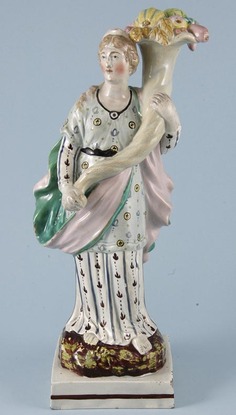
Firstly, the base is marked "WOOD & CALDWELL", so we can date this figure to between 1791 and 1818. The date given for the start of the W&C partnership is usually 1790, but James Caldwell's diary quite clearly states that the partnership commenced on Jan 1, 1791, so that is the date we should be using.
Why, you might ask, do I not know whether this figure is Plenty or Ceres? The answer is that the terms were used interchangably to refer to Ceres, who was the goddess of Plenty. Below, is a print applied to glass of the lady in question, circa 1800.
Neither of the figures above is marked. The right one (previously in the stock of Andrew Dando) appears to be from the same molds as the marked Wood & Caldwell figure, with candle holder. Perhaps it too was made by Wood & Caldwell, or by Enoch Wood, using the very same molds.
While we are on the subject of Ceres/Plenty, take a look at the Ralph Wood version, made between 1782 and 1801. (Formerly in the stock of Nick Burton.)
All these classical figures are lovely, and all come from fine dealers. If you are unsure as to what makes a fine figure, don't buy on eBay. You can rely on good dealers to only put their money into fine stock, so let them do the selection for you. Otherwise, tread carefully please.




















